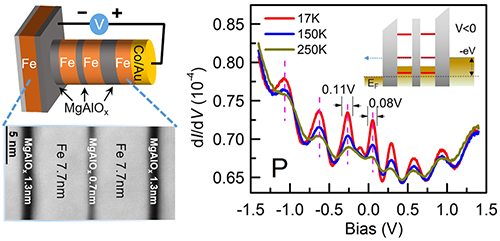Coherent Resonant Tunneling through Double Metallic Quantum Well States
Date:14-05-2019 Print
Due to its interesting scientific impact and broad applications, coherent resonant tunneling effect in magnetic tunnel junctions has aroused intensive interest from spintronic and semiconductor communities. Actually, resonant tunneling effect has been verified and utilized in semiconductor-based multi-quantum wells, such as resonant tunneling diode and light-emitting diodes with multiple quantum wells and etc. However, coherent resonant tunneling effect through metallic multi-quantum wells has been rarely reported and still a challenging topic till now, because of severe electron decoherence in metals. This coherent resonant tunneling is even more difficult for magnetic metal systems due to their shorter coherence lengths.
In 2014, a group led by Prof. Xiufeng Han in Institute of Physics Chinese Academy of Sciences, via cooperation with Dr. Yuan Lu, Prof. S. Mangin and Prof. M. Hehn in Universite? de Lorraine CNRS Institut Jean Lamour, has elaborately designed and successfully grown epitaxial magnetic tunnel junctions with double MgAl2O4 single-crystalline barriers. The core structure is Fe(001)/MgAlOx/Fe(d)/MgAlOx/Fe. As the thickness of the middle Fe (d) is 6.3nm, 7.5nm and 12.6nm, clear oscillation in differential conductance as a function of applied bias is unambiguously observed, confirming formation of quantum well states between the MgAlOx barriers. The quantum oscillation can still be observable in such thick iron films because very tiny lattice mismatch between iron and MgAlOx barrier and epitaxial growth of the whole stacks. In this case, interfacial strains and defects are minimized and phase decoherence introduced by interfacial scattering is reduced as well. Electrons can maintain their phase coherence through a long distance and strong oscillation is thus naturally achieved even at room temperatures. Due to importance of realization quantum well states in double barrier magnetic tunnel junctions at room temperature, this work has been published in Physical Review Letters [B. S. Tao, H. X. Yang, Y. L. Zuo, X. Devaux, G. Lengaigne, M. Hehn, D. Lacour, S. Andrieu, M. Chshiev, T. Hauet, F. Montaigne, S. Mangin, X. F. Han*, Y. Lu*, Phys. Rev. Lett. 115 (2015) 157204]. Based on this pioneering work, Prof. Han and his cooperators further try to realize coherent resonant tunneling effect between different quantum well states such as double quantum wells.
As the first step, stacks of Fe/MgAlOx(3 MLs)/Fe(9 nm)/MgAlOx(6 MLs)/Fe(9 nm)/ MgAlOx(3 MLs)/Fe with three barriers has been epitaxially grown to form two quantum wells. Because the bottom and the top barriers are much thinner than the middle one, applied bias dominantly drops on the middle barrier and Fermi levels of the two quantum wells are thus pinned by Fermi level of two outer electrodes. In this case, no matter positive or negative bias is applied, only states in one quantum well can be scanned. In experiment, as a result, symmetrical conductance oscillation under positive and negative bias is observed as expected, which confirms formation of double quantum wells with nearly equal energy spacing.
In the following, in order to realize coherent resonant tunneling between the quantum wells, other three rigid conditions should be fulfilled. (1) Quantum wells should have the same thickness to make well states have the same energy spacing. (2) Fermi levels of quantum wells cannot be pinned by electrodes to make these well states accessible by scanning bias. (3) Voltage dropped on the middle barrier should be as small as possible to make corresponding states from the two quantum wells keep similar energies. To satisfy the above requirements, the following stacks are grown: Fe/ MgAlOx(6 MLs)/Fe(7.7 nm)/MgAlOx(3 MLs)/Fe(7.7 nm)/MgAlOx(6 MLs)/Fe. In this sample, conductance oscillation can also successfully be observed under positive and negative biases. By comparing observed peak positions and numbers with estimated counterparts from phase accumulation model, they can safely argue that electrons coherently and resonantly tunnel through well states with the same energy but from the two quantum wells simultaneously. Furthermore oscillation peak in the double well sample has one half width of those in single well sample, also confirming the coherent and resonant tunneling effect.
This work reports coherently resonant tunneling between double well magnetic tunnel junctions for the first time, which sets a solid experimental base for developing novel spintronic devices making use of resonant tunneling effects. This work has been published in Nano Letters. [B. S. Tao, C. H. Wan, P. Tang, J. F. Feng, H. X. Wei, X. Wang, S. Andrieu, H. X. Yang, M. Chshiev, X. Devaux, T. Hauet, F. Montaigne, S. Mangin, M. Hehn, D. Lacour, X. F. Han, Y. Lu. Coherent Resonant Tunneling through Double Metallic Quantum Well States. Nano Lett. 19 (2019) 3019–3026]. This work has been financially supported by NSFC, State Key R&D Projects of MOST, China-France bilateral Cooperation and Exchange Projects and Chinese Academy of Sciences.

Fig. 1 Left panel: Schematic diagram and high resolution STEM images of magnetic tunnel junctions with three barriers Fe/MgAlOx(6 MLs)/Fe(7.7 nm)/MgAlOx(3 MLs)/Fe(7.7 nm)/MgAlOx(6 MLs)/Fe. Right panel: conductance oscillation under positive and negative biases. Inset shows schematics how electrons coherently and resonantly tunnel through two quantum wells at the same energy level.


